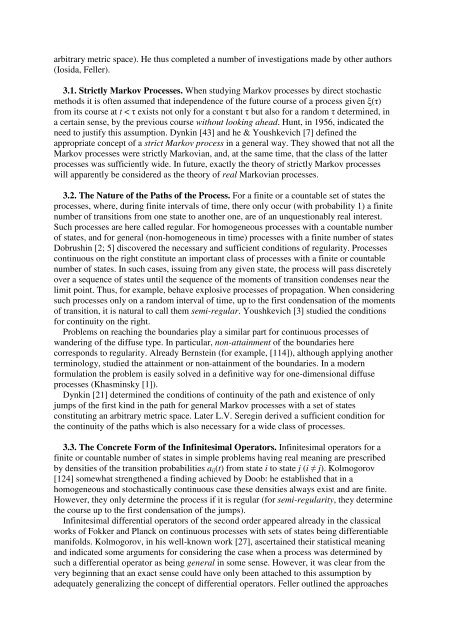7. Probability and Statistics Soviet Essays - Sheynin, Oscar
7. Probability and Statistics Soviet Essays - Sheynin, Oscar
7. Probability and Statistics Soviet Essays - Sheynin, Oscar
Create successful ePaper yourself
Turn your PDF publications into a flip-book with our unique Google optimized e-Paper software.
arbitrary metric space). He thus completed a number of investigations made by other authors(Iosida, Feller).3.1. Strictly Markov Processes. When studying Markov processes by direct stochasticmethods it is often assumed that independence of the future course of a process given ( )from its course at t < exists not only for a constant but also for a r<strong>and</strong>om determined, ina certain sense, by the previous course without looking ahead. Hunt, in 1956, indicated theneed to justify this assumption. Dynkin [43] <strong>and</strong> he & Youshkevich [7] defined theappropriate concept of a strict Markov process in a general way. They showed that not all theMarkov processes were strictly Markovian, <strong>and</strong>, at the same time, that the class of the latterprocesses was sufficiently wide. In future, exactly the theory of strictly Markov processeswill apparently be considered as the theory of real Markovian processes.3.2. The Nature of the Paths of the Process. For a finite or a countable set of states theprocesses, where, during finite intervals of time, there only occur (with probability 1) a finitenumber of transitions from one state to another one, are of an unquestionably real interest.Such processes are here called regular. For homogeneous processes with a countable numberof states, <strong>and</strong> for general (non-homogeneous in time) processes with a finite number of statesDobrushin [2; 5] discovered the necessary <strong>and</strong> sufficient conditions of regularity. Processescontinuous on the right constitute an important class of processes with a finite or countablenumber of states. In such cases, issuing from any given state, the process will pass discretelyover a sequence of states until the sequence of the moments of transition condenses near thelimit point. Thus, for example, behave explosive processes of propagation. When consideringsuch processes only on a r<strong>and</strong>om interval of time, up to the first condensation of the momentsof transition, it is natural to call them semi-regular. Youshkevich [3] studied the conditionsfor continuity on the right.Problems on reaching the boundaries play a similar part for continuous processes ofw<strong>and</strong>ering of the diffuse type. In particular, non-attainment of the boundaries herecorresponds to regularity. Already Bernstein (for example, [114]), although applying anotherterminology, studied the attainment or non-attainment of the boundaries. In a modernformulation the problem is easily solved in a definitive way for one-dimensional diffuseprocesses (Khasminsky [1]).Dynkin [21] determined the conditions of continuity of the path <strong>and</strong> existence of onlyjumps of the first kind in the path for general Markov processes with a set of statesconstituting an arbitrary metric space. Later L.V. Seregin derived a sufficient condition forthe continuity of the paths which is also necessary for a wide class of processes.3.3. The Concrete Form of the Infinitesimal Operators. Infinitesimal operators for afinite or countable number of states in simple problems having real meaning are prescribedby densities of the transition probabilities a ij (t) from state i to state j (i 2 j). Kolmogorov[124] somewhat strengthened a finding achieved by Doob: he established that in ahomogeneous <strong>and</strong> stochastically continuous case these densities always exist <strong>and</strong> are finite.However, they only determine the process if it is regular (for semi-regularity, they determinethe course up to the first condensation of the jumps).Infinitesimal differential operators of the second order appeared already in the classicalworks of Fokker <strong>and</strong> Planck on continuous processes with sets of states being differentiablemanifolds. Kolmogorov, in his well-known work [27], ascertained their statistical meaning<strong>and</strong> indicated some arguments for considering the case when a process was determined bysuch a differential operator as being general in some sense. However, it was clear from thevery beginning that an exact sense could have only been attached to this assumption byadequately generalizing the concept of differential operators. Feller outlined the approaches









